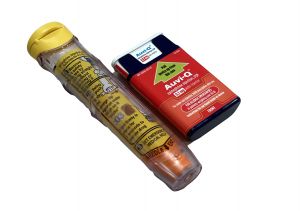Food allergy reactions can range from mild to severe, and in some cases, they can even be life-threatening. Understanding the signs and symptoms of a food allergy is crucial for your or your child’s safety. The first step to taking control of your food allergies is to seek a professional diagnosis, and ultimately an effective, safe, and rewarding treatment plan.
What is a Food Allergy Reaction?
A food allergy reaction is a physiological response that is triggered by ingesting a specific food. What makes a food allergy reaction different from a food sensitivity or intolerance? While food sensitivities most often involve the digestive system, food allergy reactions can involve multiple systems and are triggered by the immune system.
In a food allergy reaction, the immune system recognizes the food as a dangerous invader, and reacts as if it is fighting off an infection. An allergic reaction stimulates the release of chemicals (such as histamines), resulting in a variety of symptoms that can range from mild and uncomfortable to severe and life-threatening.
Mild to Severe Food Allergy Symptoms
Food allergy symptoms can spread throughout the body, including the mouth, hands, feet, skin, and gut. An allergic reaction may occur anywhere between a few minutes to a few hours after eating, triggering mild to severe symptoms. Some of the most common mild food allergy symptoms include:
-
- Mild itching
- Mild hives
- Abdominal cramps
- Sneezing
- Watery or itchy eyes
- Itching or tingling sensations in the mouth
What is Anaphylaxis?
 Severe food allergy reactions can quickly become life-threatening and result in anaphylaxis. Anaphylaxis occurs when the immune system sends a rush of chemicals to fight off the invading proteins, causing the body to go into anaphylactic shock. Once anaphylaxis occurs, an injection of epinephrine (adrenaline) is the only effective treatment. If anaphylaxis is suspected, inject epinephrine, and then seek emergency care.
Severe food allergy reactions can quickly become life-threatening and result in anaphylaxis. Anaphylaxis occurs when the immune system sends a rush of chemicals to fight off the invading proteins, causing the body to go into anaphylactic shock. Once anaphylaxis occurs, an injection of epinephrine (adrenaline) is the only effective treatment. If anaphylaxis is suspected, inject epinephrine, and then seek emergency care.
Signs of anaphylaxis include:
-
- Wheezing
- Shortness of breath
- Repetitive vomiting
- Widespread hives
- Swelling in the lips, tongue, or throat
- Weak and rapid pulse
- Dizziness or fainting
- Low blood pressure
- Constricted airways
- Difficulty swallowing or speaking
- Difficulty breathing
The number of emergency anaphylaxis cases caused by food allergies is on the rise, increasing nearly 380 percent between 2007 and 2016. Consider using this downloadable form from FARE to create your own anaphylaxis emergency plan to ensure that you are fully prepared for accidental contact with or ingestion of a food allergen.
Recognizing the Signs of Food Allergies in Children
An estimated 8 percent of children in the U.S. suffer from at least one food allergy; of that group, approximately 40 percent have more than one food allergy. Do you think your child may have a food allergy? More importantly, how would you recognize a food allergy reaction? Children have their own unique way of expressing themselves, and that includes expressing how their bodies are reacting to certain foods.
Learning how to recognize the signs of food allergy in children can help you react immediately during an allergic reaction, minimizing time to get emergency care. FARE lists the most common physical signs of a food allergy reaction in children as:
-
- Scratching or pulling at their tongues
- Slurring their words
- Change in voice (e.g., they may sound squeaky or hoarse)
Just as they have unique ways of showing they are experiencing an allergic reaction, children have equally unique ways of talking about it. The list below from FARE provides an overview of the types of phrases you may hear your child saying when they are experiencing an allergic reaction:
-
- “This food is too spicy.”
- “My tongue [or mouth] is hot [or burning, tingling, itching].”
- “It feels like something’s poking my tongue.”
- “My tongue feels like there is hair on it.”
- “My tongue feels full [or heavy, funny].”
- “There’s something stuck in my throat.”
- “It feels like a bump is on the back of my tongue [or throat].”
- “My lips feel tight.”
- “It feels like there are bugs in there [itchy ears].”
- “My eyes are burning [or itchy].”
- “My skin feels itchy.”
- “My chest is tight.”
- “My stomach hurts.”
- “My chest is tight.”
If your child uses these types of phrases after eating, they may have a food allergy. In some cases, a child who is in the midst of an allergic reaction may only describe it as, “Something is wrong,” or “Something bad is happening.” If your child is exhibiting any severe symptoms (such as wheezing, dizziness, or severe swelling), seek help immediately, use epinephrine and call 911.
Food Allergy Testing at Latitude Food Allergy Care
There are four ways to clinically determine whether someone has a food allergy. These include:

